All sailors are performance oriented. It’s only when we delve into the details that differences arise. One-design racers know that their place in the fleet hinges on tactics as well as boat speed. Those racing to Bermuda, Hawaii or even more distant landfalls, discover that a timely finish depends upon boat speed in the fog, in the middle-of-the-night and during light air interludes—not just when everyone is rolling along at hull speed.
A cruiser faces a different quest. Their perspective on performance is shaped by a smaller crew members, more reliance on self-steering gear and a propensity to enjoy the ride rather than shave seconds off each mile. So, when it comes to defining your performance perspective, make sure you and your crew agree on the traffic lane in which you prefer to sail and make sure your boat aids and abets that effort.
Background
Race boat designers are innovators, and when it comes to an empirical approach to yacht design, they and their computers juggle a wide range of variables. Speed under sail isn’t the only frame of reference. At the same time they also have to contend with rating rules meant to penalize what makes a sailboat go fast. The goal is to come up with a design that favors boat speed, safety, sail-handling efficiency and creates a sailboat that’s minimally penalized by the rating rule. At times this “shaped to a rule” approach can lead to some unwanted attributes. In this overview, we will ignore the trend to design to a rating rule and look at the features that make some sailboats much better performers than others.
Our version of performance is more than a singular focus on polar diagrams and boat speed. We agree that good performance needs to be realized in a wide range of wind and sea states. But we also place considerable emphasis on seaworthiness, seakindliness, ease of boat handling and crew comfort. These can be contradictory elements, and which gets most emphasis helps to define the differences among the sailboats being built today.
Boat speed-related features are fairly easy to recognize. For example, most sailors have caught on to the idea that tall rigs, large sail plans and light displacement are more than a subtle promise of speed. Shorter rigs, sprouting from heavy displacement hulls are fine in windy parts of the world. But they don’t deliver much drive in light air. When a yacht broker mentions that, “you don’t need to tuck in a reef until it’s blowing over 25 knots,” take a close look at the rig and the vessels displacement. Then ask yourself if it’s not more likely that delayed sail shortening is really due to a shortfall in sail area? You can also answer the question by working out the sail-area to-displacement ratio following the details below or go online to www.tomdove.com/sailcalc/sailcalc.html. The answer gives you a good idea of the boat’s potential power under sail.
Decades ago, in the heyday of the cruiser/racer, a single design stereotype defined most of the fleet. In those days, the majority of sailboats on Long Island Sound, Tampa Bay or berthed in Marina del Rey slips were white hulled sloops sporting blue mainsail covers. This was an egalitarian era when cruisers raced and racers cruised. The net result was better seamanship. Cruisers could set spinnakers and racers knew how to anchor. Today, sailboats have become more differentiated. The fast, agile, nicely fitted out cruiser/race is still around by much less common. The result is even fewer racers are going cruising. Modern race boat deck layouts make anchoring a gymnastic event and there’s little likelihood that there’s even a properly sized anchor on board. Cruisers are missing out on the seamanship development linked to racing and how it benefits sail handling while cruising.
Yacht design guru Bill Lee, coined the apt phrase “Fast is Fun.” He also recognizes that too fast can be trouble and what defines the latter is often determined by the skill set of the crew. Knowing when and how to shorten sail is a talent every sailor should cultivate. Some put that lesson on hold, and that’s OK as long as they master the art of avoiding challenging situations. This is hard to do and can lead to a lot of anxiety. Plus, it also takes much of the fun out of sailing. It’s better to prepare your boat and her crew to cope with the unexpected. This begins with developing an awareness of the boundary between being reasonably powered up versus being on the edge, about to lose control. It’s not a situation enumerated by a specific boat speed, wind velocity or angle of heel. But as one crusty old Maine coast cruiser put it, ”I can’t say exactly where trouble lies, but you’ll know when you get there.” The best solution is knowing how to depower in a hurry and safely cope with reductions in sail area.

strength-to-weight ratio. Its high sail-area-displacement ratio of 24.1 qualifies the J/99 as a “fast is fun” racer/cruiser.
Singlehanders, along with most shorthanded crews, really value the uptick in performance they get from the right gear. It improves efficiency in reefing, setting and dousing sails. Cruisers with an aversion to performance sailing have usually been through too many fire drills. Their version of how much sail area to set is often based upon bad experiences with less than adequate gear. Today’s sailing hardware and furling systems are rugged and reliable, but they still need to be carefully maintained. The crew must also know how to operate the gear in all kinds of conditions—from a midday thunderstorm to a midnight gale.
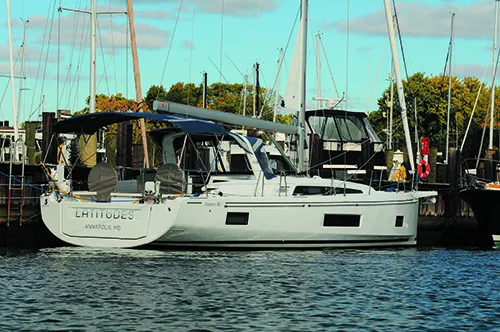
What to look for
The next time you go to a local boat show, do a little DIY performance profiling. At most shows, you’re likely to run into a full spectrum of sailboat designs. Start with the speedsters and tally up the go fast features. Sail area leads the list and with it comes lower windage, lighter weight rigging and spars—all have benefitted from better engineering and higher modulus materials.
A GZ curve illustrates righting lever. The high peak represents a boat’s maximum righting arm, which is only a part of the overall stability picture.

An offshore sailboat should have a limit of positive stability (LPS) (also known as the angle of vanishing stability- AVS) of 120 degrees or more. It is this ability to recover from a deep capsize that’s like money in the bank to every offshore passagemaker.
- The area under the positive portion of the GZ curve should be compared with the area under the negative portion. The higher the ratio between the two, the more seaworthy and less likely a monohull is to capsize and the more likely it will recover from a deep knock down.
- Lowering ballast lowers the CG and increases a vessel’s limit of positive stability. In these examples, three identical 30 footers with the same amount of ballast, but differing keel stub depths, alter their draft and GZ curves. Boat 1 (5’ draft), Boat 2 (6’ draft) and Boat 3 (4’ draft). Note that Boat 3, the shoal draft option, has the lowest LPS and Boat 2, has the deepest draft, highest LPS and will sail to windward better than the other two boats.
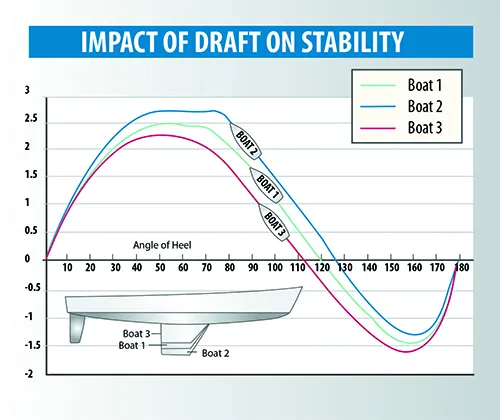

A growing concern among many offshore cruisers has been a trend toward increased beam, diminished draft and a reduction in ballast. Sailing a reach makes these design changes less noticeable, but as soon as you harden up, a performance shortfall comes into play. With less ballast and no one perched on the rail, excessive heel necessitates a reef. In many cases, the shallow draft keel is almost completely hidden as the leeward portion of the hull submerges. This causes the sailboat to slide sideways and every beat to windward becomes a lesson in leeway.
The preference for deep draft is one thing that hasn’t changed too much among race boat designers. Centerboards, dagger boards, drop keels and can’ting keels are also in the mix. And it’s clear that there’s been a downward trend in displacement that fits into the performance-enhancing puzzle. Today, the “less is more” rule prevails. In the 1980s, a race-winning, IMS 40-footer weighed around 18,000 pounds. Now many 40 footers tip the scale at around 10,000 pounds and carry more sail area than their predecessor. The trend flips, however, when it comes to the price tags and sticker shock. It gets quite expensive to shave weight and add speed due to the need for more esoteric materials and aerospace construction skills. The bottom line is how much is it worth to you to add a few tenths of a knot?

Multihull aficionados continue to assail the logic of lead. Monohull designers are using less but locating it more strategically at the tip of a high aspect ratio foil. This lowers the CG, increasing the righting moment but greatly adds to the stress focused at the keel to hull junction. Keel failures have become enough of an issue that the ISAF Technical Committee has been looking into the problem and they are favoring recommendations that builders increase the hull laminate thickness in the area around the keel attachment. This is a good example of how performance-enhancing features must be considered in the greater context of overall vessel design and construction. Good performance is desirable, staying afloat is essential.
Stability Examined
Righting moment and buoyancy are forces that work together to resist the heel induced by wind pressure on the sail plan. The more sail area, the greater the heeling moment. Multihulls have very high initial stability that’s derived from their wide beam. Monohulls have less initial stability, so when sailing to windward they soon begin to heel over. However, their “ace in the hole” is a highly appreciated attribute called secondary righting moment. It’s derived from ballast and keel geometry.
Multihulls might have been a side show a few decades ago, but they now hold a mainstream role in the sailboat marketplace. Like cruising monohulls, they range from comfortable houseboat like cruisers to absolute speedsters. The latter features more sail area, lighter displacement and much more clearance between the sea surface and the underside of the bridge deck.
Fixed wing masts, C and T foils and all carbon construction can help to juice up the ride. However, the downside to state-of-the-art, aircraft quality carbon fiber construction, seen aboard $7.8 million Fast Forward Composites Eagle 53, can result in serious sticker shock. But the ride says it all, acceleration with the fixed-wing spar is near instantaneous. Time will tell if it’s all just too radical or a full-scale glimpse of what lies ahead.
Displacement/length ratio
I prefer to preview a sail in a new boat by tallying up the numbers. For example, the J/99 is a 32’ J/Boats, Inc racer/cruiser with enough Spartan accommodations below to do some fast passage making. She looked like a double-hander’s delight and with an ISO Cat A rating and the following vital signs, the performance potential is clear:
8,900 lbs. displacement
6.5 ft. draft
11.2 ft. beam
137 limit of positive stability
37 percent ballast ratio
170 D/L ratio
24.1 SA/D ratio
The data indicated an excellent performer in a wide range of wind speeds and the boat lived up to expectations.
For decades, naval architects and yacht designers have been putting complex as well as simple equations to good use. We’ll take a look at a few of the latter and see how they can help to put a more definitive label on specific sailboats.
Displacement length ratio is a comparative tool that allows us to group sailboats into five different performance categories. The ratio itself is a non-dimensional number that defines the relationship between weight and length of a vessel. Most sailboats fall between 100 and 400 on this rating scale. At the low end reside light weight speedsters and at the high end are heavy vessels that need a lot more sail area to attain the performance of vessels toward the lower end of the scale. The D/L ratio is a handy way to empirically make boat-to-boat comparisons.
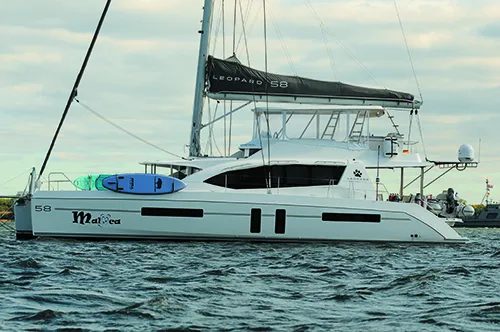
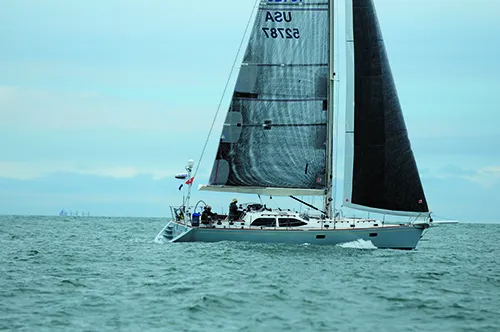
The equation used in this calculation is based on a vessel weight expressed in long tons (2,240 pounds) and the load waterline length (LWL) measured in feet. Don’t let the math bother you. It can be followed like a recipe and a calculator will insure the accuracy of your arithmetic. D/L = DLT ÷ (0.01 X LWL)3
So, let’s assume we are calculating the D/L ratio of a sailboat with a 32’LWL and 18,000 pounds of displacement:
- Convert displacement (D) in pounds to D in long tons (18,000 ÷ 2,240 = 8.0357)
- Multiply the constant 0.01 times the 32’ LWL (0.01 x 32 = .32)
- Cube the result (.323 = .0328)
- Divide displacement (in long tons) by the modified LWL (8.0357 ÷ .0328 = 245)
- The displacement length ratio is 245, it lies in the upper half of the moderate category, a highly populated portion of the scale and a region representative of many offshore cruising boats. (Ultralight <90, Light 90 – 180, Moderate 180 – 270, Heavy 270 – 360, Ultraheavy > 360)
When looking at D/L ratios, it’s important to know the trim state of the vessel when it was measured. The weight of fuel, water and a cruising payload will affect the trim. Brochures often provide “light trim” statistics, but “half trim” status is used by most designers and presents a more realistic profile.
Whatever the case, make sure that the boats you compare are all in the same state of trim. The lighter the vessel, the more of an impact a sizeable payload will have. Also recognize that sailboats with no overhang and those with long overhangs skew the ratios in opposite directions. Plumb bowed, long LWL vessels earn lower ratios while long overhangs contribute to higher ratios.
Sail Area/displacement ratio
Sail-area/displacement ratio is a performance-linked statistic that defines potential power under sail. The comparative metrics are vessel displacement and sail area—a sailor’s rendition of an automotive horsepower-to-weight ratio. In this case, sail area is measured in square feet or meters. No attention is given to how efficient or inefficient the hull shape happens to be. In other words, it doesn’t matter if the hull shape looks like the city dock or the underbody of the first to finish in the Newport-to-Bermuda Race. As long as their displacements and working sail area are the same, so will their SA/D ratios. The value of this metric lies in its ability to depict potential power for a given displacement—another useful tool in boat-to-boat evaluations. Solving the equation does involve changing vessel weight into the volume of water it displaces.
Headsail area in the formulae below refers to the working sail area or more specifically (J x I) ÷ 2 = SA (headsail). The mainsail area has become the actual square footage because the large roach (race boats) or the hollow leech (associated with in-mast furling systems) cause simple triangle area calculations to be too inaccurate.
In the following calculation we look at a sailboat that displaces 18,000 pounds and has a working sail area of 750 square feet.
- Convert water volume to weight one cubic foot of salt water = 64 pounds (18,000 ÷ 64 = 281.25)
- Calculate the sail-area displacement using (SA/D = SA sq.ft. ÷ (D cu.ft. ÷ 64)2/3) (750 ÷ (281.25)2/3 = 17.44)
- So our SA/D is 17.44, which puts it near the top of good performance. (<15 under-canvased, 15-18 good performance, 18-20 excellent performance, 20< a handful)
Ballast ratio
Ballast Ratio—is a quick and easy calculation that doesn’t involve long tons or a weight-to-water volume conversion. It’s a simple comparison of weight of ballast to weight of the entire boat calculation, expressed as a percentage. B ratio = (Bwt ÷ Disp) x 100.
Assume an 18,000 pound sailboat has 7,200 pounds of ballast.
B#ratio = (8200 ÷ 18000) x 100 = .40
A 40 percent ballast ratio contributes to a sailboat’s secondary righting moment. How much it contributes,depends on how deep the ballast is placed. The big plus behind a substantial secondary righting moment is that it results in a very small negative portion to the boat’s stability curve. This means that the vessel is much less likely to capsize and quite able to quickly recover from a deep knock down.

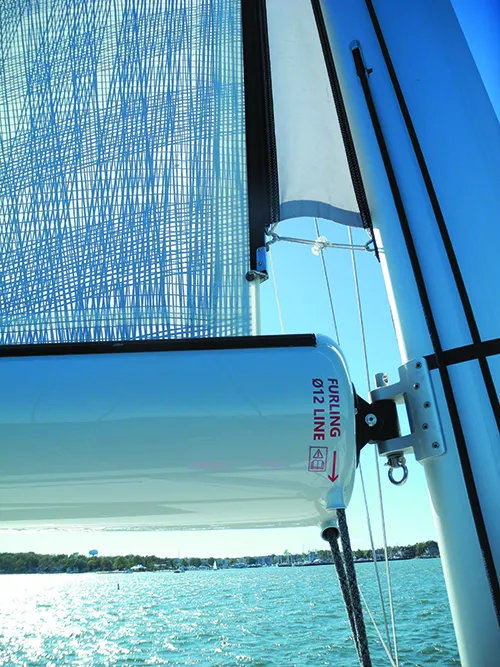
Many naval architects consider a 120°-130° limit of positive (LPS) a minimum for smaller to mid-sized offshore cruising sailboats. This can be accomplished with a high ballast ratio and less draft or a lower ballast ratio and deeper draft. The latter often entails a fin and bulb or anvil shape at the very tip of the keel.
These numbers aren’t SAT scores and higher isn’t better. They should be thought of as a sequel to a compass heading rather than a patient’s vital signs. For those targeting a specific type of sailing—a high latitude ocean crossing, for example—it makes sense to favor a mid-range D/L ratio and the “good performance” range of the SA/D ratio. It’s also important to take a close look at the ballast ratio in conjunction with the boat’s LPS.
Those cruising summer weekends, exploring anchorages close to home, don’t need to lug along as much lead or iron and can look favorably at ballast ratios around 30 percent. However, if it’s a light to ultra-light displacement, a beamy boat with a high SA/D ratio and a shoal-draft keel, beware of a low ballast ratio. This combination means you’ll need lots of friends on the rail when it starts to blow and if you heel beyond the initial righting moment’s sweet spot (around 40-60 degrees) there’s very little secondary righting moment to prevent a knock down.
Multihull sailors put all their eggs in one basket, but it’s a big basket. Extreme beam delivers immense initial stability that peaks around 10-15 degrees of heel. With this powerful heel stopping ability there’s an assumption the secondary righting moment will never be needed. Sailed appropriately, and never caught over canvassed, the initial stability does its job.
However, no multihull designer or builder offers a “can’t be capsized” warranty. Avoiding that outcome is the job of the skipper and crew who must keep careful track of the sail area set, the sea state being encountered and the potential for major fluctuations in wind velocity. Wave face geometry and a changing water plane also affect capsize avoidance. It’s no surprise that the SA/D and D/L ratios of the multihulls in the charter trade are very different than the same ratios calculated for the multihulls that race to Bermuda.
Conclusion
Sailboats, like automobiles, are designed to excel at specific jobs. Just as a Ford F-150 and a Ferrari 488 Spider have decidedly different missions, so does an Island Packet 42 Motor Sailor and a Farr 400. In between these two specialty boats lies a wide range of other sailboats that target a compromise between the two. Sailors, like the boats available, range significantly in how they prefer to spend time on the water.
Hopefully, those seeking to make fast passages end up aboard a boat that can perform up to those standards. And likewise, those out to savor slower meandering and enjoy a comfortable life aboard won’t step below into a cabin lacking head room, festooned with pipe berths, and accessorized with a two burner camping stove and an unenclosed head. The same goes for performance upgrades and making decisions as to whether to invest in light wind sails or add another fuel tank to bump up range under power. Perhaps both.
Contributing Editor Ralph Naranjo is the author of The Art of Seamanship. He is an adjunct lecturer at the Annapolis School of Seamanship.


































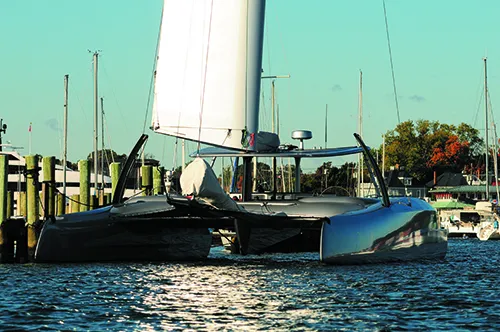





Thanks Ralph a well put together article with very little bias. Very impressive.
Likewise to above. I’ve tried many times to lay this information out for relatively new sailboat buyers and I wish I could do it half as well as Ralph did in this article.
Bravo, Matey
Ralph – recheck your math and formula for SA/D…
Not clear if you multiply the entire formula by 2/3 or juts the denominator – either way it does not seem to come out as you show.
very good
Last year, due to delamination and lots of water intrusion, I replaced the ‘barn door’ rudder on my ‘83 Cal 35 with a slightly shorter and more elliptically shaped rudder. There was a noticeable difference in performance and I moved up more than several places in the one race I enter every year.
D/L is not a dimensionless number (it’s dimensions are are long ton / ft3), neither is SA/D (ft2/ton). Nevertheless, the numbers can be useful at least when comparing boats with similar hull shapes.
Some more discussion of the impact of hull shape (i.e. impact of hard chines, impact of location of max beam, amount of buoyancy in bow & stern, etc.) would be meaningful, as (esp the french) modern cruisers and races have dramatically different shapes than 1970s or 80s cruisers and behave quite differently when compared at similar ratios.
Very nice article. I think the confusion about the 2/3 factor is that the denominator is taken to the 2/3 power. So the equation for denominator is (D in pounds / 64)**2/3. I believe the ** or ^ symbol is missing. Again, good overview with excellent examples. Jim